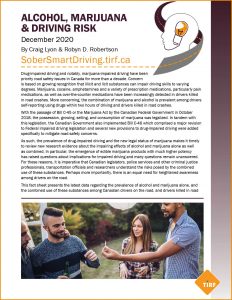Ottawa, ON June 22, 2021 – The Traffic Injury Research Foundation (TIRF) announces the release of a new fact sheet, Alcohol, Marijuana & Driving Risk, sponsored by Beer Canada. It reviews research regarding the effects of alcohol and marijuana on crash risk, as well as the effects of those substances combined. In concert with this release, TIRF has relaunched its impaired driving education program, Sober Smart Driving, also with funding provided by Beer Canada and in partnership with ArriveAlive. The program shares knowledge and research to answer common questions about alcohol and impaired driving. With Canada Day celebrations soon taking place and the easing of some restrictions on gatherings, it’s imperative Canadians understand the effects of alcohol on the body and driving skills.

“Police-reported data, as well as crash data, demonstrate impaired drivers often test positive for more than one substance. Some of these drivers pose an even greater risk on the road and much more work is needed to fully understand the impairing effects of specific drug combinations,” cautions Robyn Robertson, President and CEO of TIRF. “One reason the combined use of alcohol and marijuana has more significant impairing effects on driving skills is the interaction between the drugs can increase risk-taking and users are less likely to recognize the potential negative consequences.”
A 2017 study of drivers involved in fatal crashes by the Canadian Drug Policy Coalition at Simon Fraser University showed drivers with alcohol and cannabis in their system were 3.7 times as likely to not be wearing a seatbelt compared to drivers with no alcohol or drugs. In comparison, these odds were 3.5 for alcohol and 1.55 for marijuana. In other words, results indicated drivers under the influence of alcohol and marijuana were more at risk than those using alcohol or marijuana alone.
Further research is required to fully understand the impairment effects at different doses of each substance and how these effects may differ according to the physical characteristics of drivers, consumption habits and mode of ingestion. This information can inform legislation as well as programs and strategies to reduce impaired driving.
Craig Lyon, road safety researcher, concludes, “To address important gaps in knowledge associated with the impairing effects on driving of alcohol in combination with marijuana, researchers are encouraged to investigate the role of polysubstance use and the implications for effective impaired driver programs. Identification of misperceptions, characteristics of those drivers most likely to drive after consuming both alcohol and marijuana and in what situations they are likely to do so, is required to address the problem through education and enforcement.”
To help Canadians learn about the risks associated with drinking and driving, TIRF’s new Sober Smart Driving website contains downloadable fact sheets on a variety of topics, including:
drinking and its effects on driving;
- magnitude and characteristics of drinking and driving;
- basics of the impaired driving system, such as administrative penalties, vehicle impoundment, supervision, and treatment;
- impaired driver programs and penalties; and,
- myths and misconceptions about drinking & driving.
Download fact sheet & visit Sober Smart Driving:
About TIRF
Traffic Injury Research Foundation (TIRF) is an independent, charitable road safety research institute. The vision of TIRF is to ensure people using roads make it home safely every day by eliminating road deaths, serious injuries and their social costs. TIRF’s mission is to be the knowledge source for safer road users and a world leader in research, program and policy development, evaluation, and knowledge transfer. TIRF is a registered charity and depends on grants, awards, and donations to provide services for the public. Visit www.tirf.ca.
LinkedIn: Traffic Injury Research Foundation & Drop It And Drive® Program, TIRF
Facebook: TIRFCanada & Drop It And Drive®
Twitter: @TIRFCANADA & @DropItAndDrive
Instagram: @DropItAndDrive
About Sober Smart Driving:
TIRF’s Sober Smart Driving website (formerly Change the Conversation), with funding provided by Beer Canada, shares knowledge and research to answer common questions about alcohol and impaired driving. It contains facts to help Canadians learn about the risks associated with drinking and driving and encourages everyone to speak up and talk about why they choose not to drink and drive. Visit www.SoberSmartDriving.tirf.ca
– 30 –
For more information, please contact:
Karen Bowman
Director, Marketing and Communications
Traffic Injury Research Foundation
613-238-5235 (office)
1-877-238-5235 (toll-free)
250-797-0833 (direct)
613-238-5292 (fax)
tirf@tirf.ca / karenb@tirf.ca


